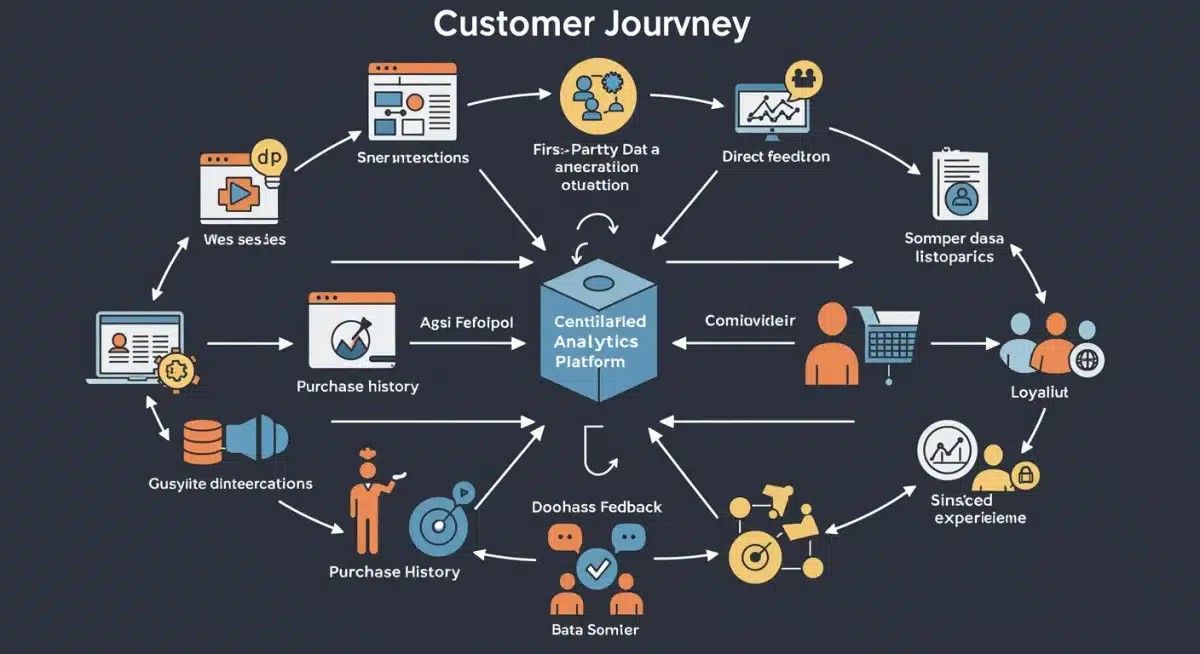First-Party Data: Boost CLV 25% by 2025 (Insider Knowledge)

First-party data is emerging as the critical driver for a projected 25% boost in Customer Lifetime Value (CLV) by 2025, offering unparalleled insights for personalized customer experiences and strategic growth.
Recent industry reports and insider analyses confirm that the strategic utilization of first-party data CLV is set to become the paramount differentiator for businesses aiming to significantly enhance customer lifetime value by 25% by 2025. This critical shift underscores a growing reliance on direct customer relationships and proprietary insights in an increasingly privacy-centric digital landscape.
The Imperative of First-Party Data in 2024
The digital marketing landscape is rapidly evolving, with privacy regulations and the deprecation of third-party cookies pushing businesses towards more sustainable data strategies. As of early 2024, first-party data has moved from a strategic advantage to an absolute necessity. Companies that have proactively invested in collecting, managing, and activating their own customer data are already reporting significant gains in customer engagement and retention.
This shift is not merely compliance-driven; it represents a fundamental change in how brands build relationships with their customers. By owning the data, businesses gain a clearer, more accurate picture of individual preferences and behaviors, enabling deeply personalized experiences that resonate with consumers. This direct relationship fosters trust, which is invaluable in today’s market.
Understanding First-Party Data Collection
Collecting first-party data involves gathering information directly from your audience through various touchpoints. This can include website interactions, purchase history, customer feedback, and direct communications. The authenticity and relevance of this data are unmatched by any other source.
- Website/App Analytics: Tracking user behavior, page views, and interactions.
- CRM Systems: Storing purchase history, customer service interactions, and demographic data.
- Surveys and Feedback: Direct input on preferences, satisfaction, and needs.
- Subscription Services: Email sign-ups, loyalty programs, and content subscriptions.
Boosting Customer Lifetime Value (CLV) Through Data
The direct correlation between robust first-party data strategies and increased Customer Lifetime Value (CLV) is now undeniable. By understanding customer journeys and preferences at a granular level, businesses can tailor communications, product offerings, and support, leading to enhanced satisfaction and loyalty. This personalized approach extends the duration of customer relationships and increases their overall value.
Recent case studies highlight companies that have implemented sophisticated first-party data platforms, reporting up to a 20% increase in repeat purchases and a 15% reduction in churn rates within the first year. These statistics underscore the tangible financial benefits of moving away from generalized marketing tactics towards data-driven personalization. The goal for a 25% CLV boost by 2025 is seen as ambitious but achievable for those fully embracing this data paradigm.
Personalization as a Core Driver
Effective personalization, powered by first-party data, goes beyond simply addressing a customer by their name. It involves anticipating needs, recommending relevant products, and offering timely support based on past interactions and predicted future behavior. This level of foresight builds stronger emotional connections with customers.
- Tailored Product Recommendations: Suggesting items based on past purchases and browsing history.
- Personalized Content Delivery: Providing relevant articles, videos, or offers based on stated interests.
- Proactive Customer Service: Reaching out with solutions before issues escalate.
- Exclusive Loyalty Programs: Rewarding consistent engagement with customized benefits.
Strategic Implementation of First-Party Data Platforms
Implementing an effective first-party data strategy requires more than just collecting data; it demands a comprehensive approach to data management, analysis, and activation. Many organizations are now investing in Customer Data Platforms (CDPs) to unify disparate data sources and create a single, comprehensive view of each customer. This unified profile is crucial for generating actionable insights that drive CLV.
The challenge lies in integrating various data streams – from online interactions to offline purchases and customer service records – into a cohesive system. Companies must also ensure data quality and compliance with privacy regulations like GDPR and CCPA. The success of these platforms hinges on their ability to transform raw data into intelligent, personalized customer experiences.

Building a Data-Centric Culture
Beyond technology, a data-centric culture is essential. This involves training employees across all departments – from marketing to sales and customer service – on the importance of data and how to leverage it effectively. It also means fostering a mindset where decisions are consistently informed by data insights, rather than assumptions.
Successful data implementation requires cross-functional collaboration and a clear vision for how data will serve business objectives. Regular audits and updates to data collection and usage practices are also vital to maintain relevance and compliance in a dynamic regulatory environment.
Challenges and Solutions in First-Party Data Management
While the benefits of first-party data are significant, implementing and managing it effectively comes with its own set of challenges. Data silos, privacy concerns, and the need for specialized skills are common hurdles. Many organizations struggle to integrate data from various sources, leading to incomplete customer profiles and missed opportunities for personalization.
Addressing these challenges requires a multi-faceted approach. Investing in robust data governance frameworks ensures data quality and compliance. Employing data scientists and analysts, or partnering with specialized agencies, can help extract meaningful insights. Additionally, adopting privacy-enhancing technologies and transparent data practices builds customer trust, encouraging more data sharing.
Overcoming Data Silos
Data silos often arise from different departments using separate systems that don’t communicate effectively. This fragmentation prevents a holistic view of the customer. Solutions include:
- Implementing CDPs: Centralizing customer data from all touchpoints into one platform.
- API Integrations: Connecting various systems to enable seamless data flow.
- Cross-Departmental Collaboration: Fostering communication and shared goals regarding data usage.
Measuring the Impact: Metrics for First-Party Data Success
To truly understand the value of first-party data, businesses must establish clear metrics for success. Beyond the overarching goal of boosting CLV, key performance indicators (KPIs) should track how data initiatives influence customer behavior and business outcomes. These metrics provide tangible proof of return on investment and guide ongoing optimization efforts.
Relevant metrics include customer retention rates, average order value, conversion rates, and customer satisfaction scores. By continuously monitoring these indicators, companies can refine their data strategies, identify areas for improvement, and demonstrate the direct impact of first-party data on profitability. This analytical rigor is crucial for sustaining long-term growth.
Key Performance Indicators (KPIs)
Tracking the right KPIs is vital for validating the effectiveness of first-party data initiatives. These metrics help quantify the impact on customer value and overall business performance.
- Customer Retention Rate: Percentage of customers who continue to do business over time.
- Average Order Value (AOV): The average amount spent per customer transaction.
- Conversion Rate: Percentage of visitors who complete a desired action, like a purchase.
- Churn Rate: The rate at which customers stop doing business with a company.
- Net Promoter Score (NPS): A measure of customer loyalty and satisfaction.
Future Outlook: First-Party Data and AI in 2025
Looking ahead to 2025, the synergy between first-party data and artificial intelligence (AI) is expected to unlock unprecedented levels of personalization and predictive analytics. AI algorithms, fueled by rich, proprietary customer data, will enable businesses to anticipate customer needs with greater accuracy, automate hyper-personalized marketing campaigns, and optimize customer journeys in real-time. This combination will be pivotal in achieving and exceeding the 25% CLV growth target.
The continued evolution of AI will allow for more sophisticated segmentation, dynamic content generation, and predictive modeling of customer behavior. Companies that successfully integrate AI with their first-party data assets will gain a significant competitive edge, delivering experiences that are not just personalized, but truly foresightful and engaging. The future of customer relationships is deeply intertwined with these technological advancements.
The Role of Predictive Analytics
Predictive analytics, powered by AI and first-party data, will allow businesses to move beyond reactive marketing to proactive engagement. This involves forecasting future customer behavior, identifying potential churn risks, and pinpointing opportunities for upselling and cross-selling.
- Churn Prediction: Identifying customers at risk of leaving and intervening proactively.
- Next Best Offer: Recommending products or services a customer is most likely to need next.
- Customer Journey Optimization: Dynamically adjusting interactions based on real-time behavior.
| Key Point | Brief Description |
|---|---|
| CLV Growth Target | Aims for a 25% boost in Customer Lifetime Value by 2025 using first-party data. |
| Data Imperative | First-party data is essential due to privacy trends and third-party cookie deprecation. |
| Personalization Power | Deep personalization driven by direct data enhances customer satisfaction and loyalty. |
| AI Integration | Future growth relies on combining first-party data with AI for predictive analytics. |
Frequently Asked Questions About First-Party Data and CLV
First-party data is information collected directly by a company from its own customers, through its own platforms like websites, apps, CRM systems, or direct interactions. It includes browsing behavior, purchase history, demographic details, and direct feedback, making it highly accurate and relevant for personalization efforts.
By providing deep insights into customer preferences and behaviors, first-party data enables hyper-personalization of marketing, product recommendations, and customer service. This tailored approach enhances customer satisfaction, fosters loyalty, extends customer retention, and ultimately increases the total revenue generated from a customer over their relationship with the brand.
Key challenges include data silos across different departments, ensuring data quality and accuracy, navigating complex privacy regulations like GDPR and CCPA, and acquiring the necessary technical expertise for data management and analysis. Overcoming these requires robust infrastructure, clear governance, and cross-functional collaboration.
The shift is primarily driven by increasing consumer privacy concerns, tightening data regulations, and the impending deprecation of third-party cookies by major browsers. First-party data offers a more reliable, compliant, and insightful alternative, allowing businesses to maintain direct, trustworthy relationships with their customers without relying on external data sources.
By 2025, AI will significantly enhance first-party data strategies by enabling advanced predictive analytics, real-time personalization, and automated campaign optimization. AI algorithms, trained on rich first-party data, will forecast customer needs, identify churn risks, and suggest optimal interactions, driving more effective and efficient CLV growth.
What Happens Next
The trajectory towards a first-party data dominated marketing landscape is clear and accelerating. Businesses that fail to adapt their data strategies risk falling behind competitors who are already leveraging these insights to build stronger, more profitable customer relationships. Expect to see continued innovation in Customer Data Platforms (CDPs) and AI-driven analytics tools, making sophisticated data activation more accessible. Regulators will also likely continue to refine data privacy frameworks, further cementing the importance of transparent and ethical first-party data collection. The next 12-18 months will be critical for businesses to solidify their first-party data foundations and prepare for the 2025 CLV surge.





